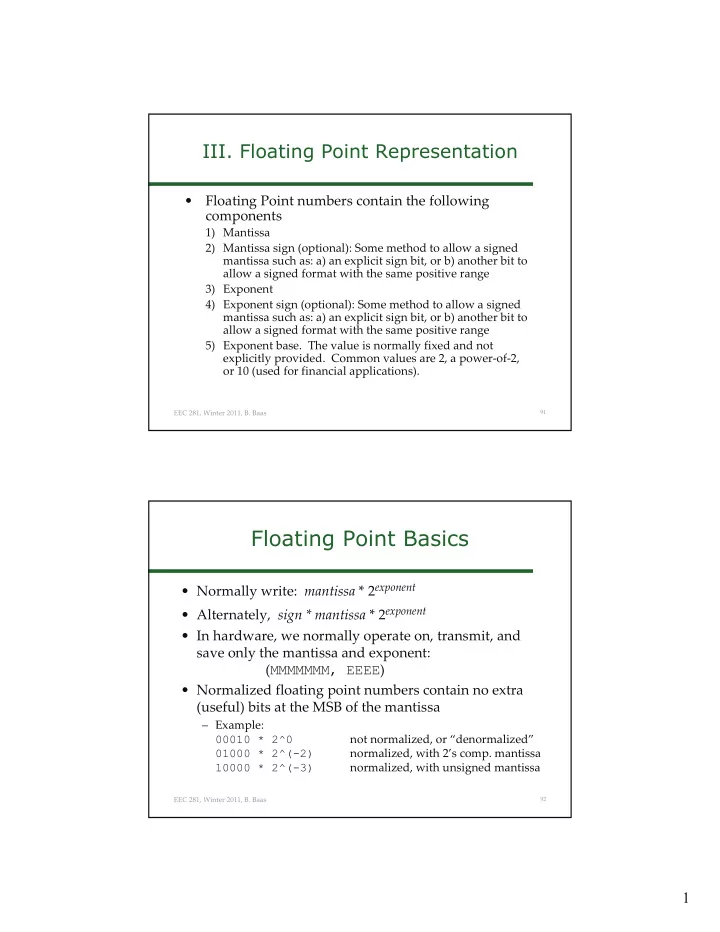

III. Floating Point Representation • Floating Point numbers contain the following components 1) Mantissa 2) Mantissa sign (optional): Some method to allow a signed mantissa such as: a) an explicit sign bit, or b) another bit to allow a signed format with the same positive range 3) Exponent 4) Exponent sign (optional): Some method to allow a signed mantissa such as: a) an explicit sign bit, or b) another bit to allow a signed format with the same positive range 5) Exponent base. The value is normally fixed and not explicitly provided. Common values are 2, a power ‐ of ‐ 2, or 10 (used for financial applications). EEC 281, Winter 2011, B. Baas 91 Floating Point Basics • Normally write: mantissa * 2 exponent • Alternately, sign * mantissa * 2 exponent • In hardware, we normally operate on, transmit, and save only the mantissa and exponent: ( MMMMMMM, EEEE ) • Normalized floating point numbers contain no extra (useful) bits at the MSB of the mantissa – Example: 00010 * 2^0 not normalized, or “denormalized” 01000 * 2^(-2) normalized, with 2’s comp. mantissa 10000 * 2^(-3) normalized, with unsigned mantissa EEC 281, Winter 2011, B. Baas 92 1
Floating Point � Fixed Point Conversion • If the exp is unsigned, the mantissa exp shifter shifts only to the left • If the exp is signed, the shifter must shift to the left and right • Example: shifter 01011. * 2 2 01011. << 2 0101100. fixed point EEC 281, Winter 2011, B. Baas 93 Fixed Point � Floating Point Conversion • Leading 0s/1s fixed point detector finds the optimum place to begin selecting bits for leading the mantissa shifter 0s/1s • Common pitfall: detector If the mantissa is signed, its sign bits must be exp mantissa maintained! EEC 281, Winter 2011, B. Baas 94 2
Floating Point • Fixed ‐ to ‐ float conversion example ( positive input) – Input: 8 ‐ bit 2’s complement (signed) integer Output: 4 ‐ bit 2’s complement (signed) mantissa a) integer mantissa 0 0 0 0 1 1 0 0. � 0 1 1 0. * 2^(001) % 2^1 12 = 6 * 2^1 b) fractional “0.4 format” mantissa 0 0 0 0 1 1 0 0. � .0 1 1 0 * 2^(101) % 2^(5) 12 = 0.375 * 2^5 EEC 281, Winter 2011, B. Baas 95 Floating Point • Fixed ‐ to ‐ float conversion example ( negative input) – Input: 8 ‐ bit 2’s complement (signed) integer Output: 4 ‐ bit 2’s complement (signed) mantissa a) integer mantissa 1 1 0 1 0 0 0 1. � 1 0 1 0. * 2^(011) % 2^3 -47 = -6 * 2^3 b) fractional “2.2 format” mantissa 1 1 0 1 0 0 0 1. � 1 0.1 0 * 2^(101) % 2^(5) -47 = -1.5 * 2^5 EEC 281, Winter 2011, B. Baas 96 3
Recommend
More recommend